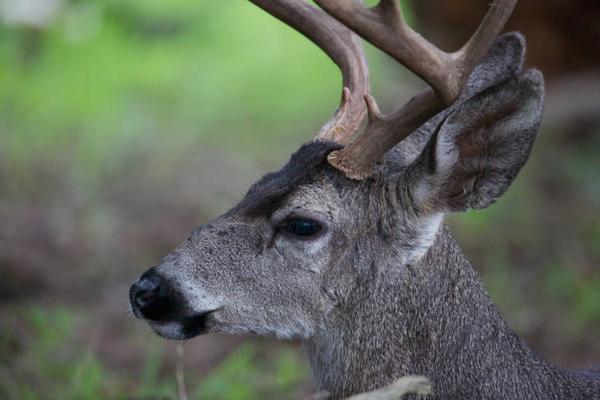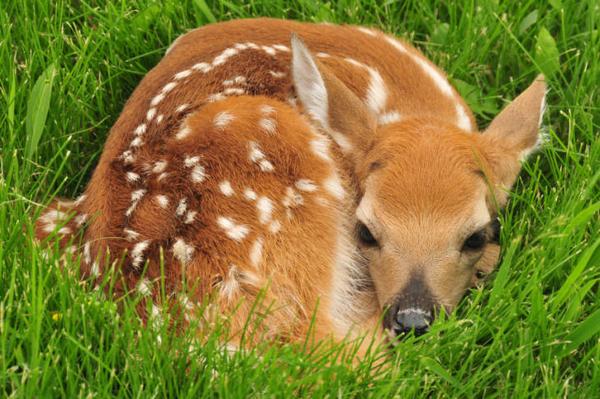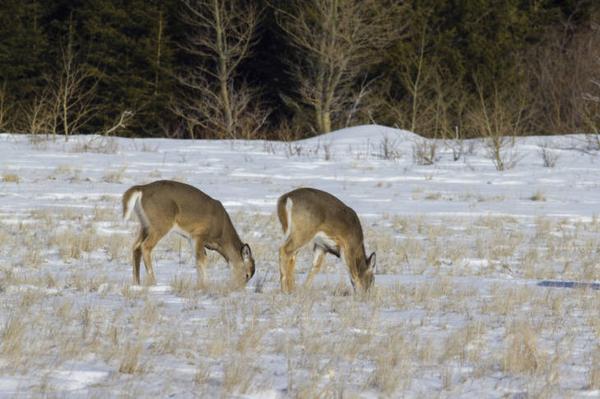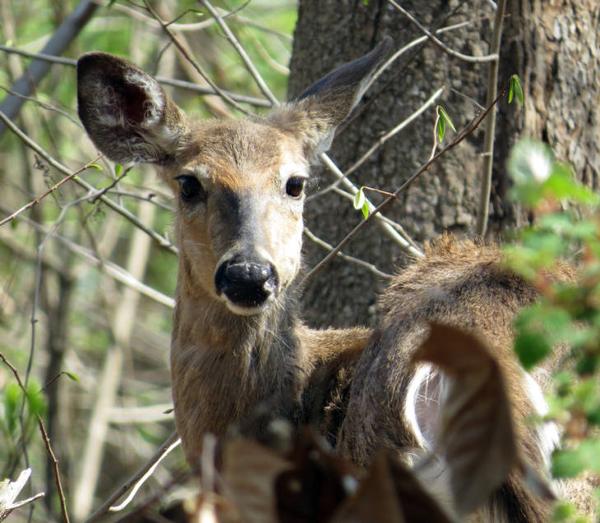White-Tailed Deer
White-tailed deer are common throughout the eastern United States. Adult males (bucks) weigh between 100 and 200 pounds, whereas females (does) weigh between 80 and 160 pounds. Fawns are born in late spring to early summer, have characteristic spotted fur, and stay with their mothers for their first year of life. Occasionally people encounter a fawn without an adult nearby. This is perfectly normal, as the doe leaves the fawn while she ventures away to feed. She will return to the fawn several times a day to care for it. White-tailed deer often live to be 5-6 years old, especially where hunting pressure is low.
Habitat Requirements
White-tailed deer are common in both urban and rural areas, adapting well to live in close proximity to humans. They are highly adaptable and use creek and river bottoms, forest plantations, croplands, mature forests, young forests, early successional vegetation, and urban areas. Deer usually prosper following prescribed fire, timber harvest, or other disturbances which produce new vegetative growth near ground level.
Food
Deer eat a variety of hard mast (e.g., acorns, beech nuts), soft mast (e.g., blackberry, blueberry), forbs, tender parts of woody plants, fungi, and agricultural crops. In fall and winter, the high priority deer foods are hard and soft mast, especially acorns, along with woody evergreen plants, herbaceous vegetation, and fungi. In the spring and summer, deer eat tender woody browse, a diverse array of forbs, and soft mast as it becomes available throughout the season. Adult deer require 6 to 8 pounds of green food per 100 pounds of body mass daily. Reproductive rates and survival during adverse winter conditions depend on the relative body fat stored during summer and fall feeding.
The abundance and quality of foods available from summer through fall largely influences the reproductive condition of deer. Nutrition, age, and genetics govern antler development. Antlers emerge in the spring and grow throughout the summer. Antler rubbing begins in August and ends by mid-October. Breeding activity peaks from late October through December. Antlers are shed from late December to mid-April. In the Southeast, the greatest stress period for deer typically is during later summer when woody vegetation is high in lignin (i.e., not easily digestible) and before acorns begin dropping. This also is the time that does are lactating, which is an energetically expensive physiological process. Hence, it’s important to manage for extensive forb cover, which is a critical food source during this time of year.
Cover
Cover needs vary somewhat depending on the time of year. During the summer, deer seek out cool microclimates, often along river or creek bottoms. Conversely, deer may bed in upland areas, including early successional vegetation communities, during other seasons.
Year-round bedding cover consists of dense young timber stands, fallow fields, old beaver ponds, or secluded hardwood swamps. Early succession vegetation, including fallow fields, frequently is used by does for fawning cover. Mowing or burning of these fields should be delayed until August to avoid killing fawns, though the best time for field management is late winter just before spring green-up.
Water
Deer require free water occasionally. Lactating females need it daily. Succulent green plants only partially meet a deer's water needs, so a lack of free water may deter deer from using certain parts of otherwise suitable range.
Home Range / Population Concerns
A deer's home range is seldom more than 300 to 400 acres in the coastal plain, piedmont or mountain regions, although bucks may range wider in the fall. If not subjected to either-sex hunting, deer populations may quickly exceed available food supplies, though the increase in coyotes and other predators may suppress populations in some landscapes. Landowners should consult with a professional biologist to set harvest goals and strategies that achieve objectives and maintain the health of the herd.
White-Tailed Deer Management
Tips for Improving Deer Habitat
General
- Retain 20% of the landscape in forest with mast-producing species (i.e. oaks, beech, and hickory)
- Keep most clearcut harvests less than 40 acres
- Use prescribed burning and disking (i.e., soil tillage) to maintain areas of early succession vegetation, which provide abundant forage in the spring and summer and provide bedding and fawning cover
Intermediate treatments
- Pre-commercially or commercially thin forest stands to promote understory
- Thin forest stands frequently (8 to 10 years), targeting basal areas of 50 to 60 square feet per acre in pine-dominated forest
- When thinning, retain a variety of mast-producing species
- Favor a mixture of red oaks and white oaks in the overstory to ensure acorns are available each fall (note: acorn crops vary annually so maintaining a variety of oak species helps reduce annual variation)
- During thinning and other timber harvest, retain individual oak trees known to be the best acorn producers (note: this requires 3 to 5 years of observation and record keeping by the landowner)
Prescribed burning
- Burn frequently (2 to 5 years) to maintain understory that provides browse, forage (forbs as food), and soft mast
- Conduct most prescribed burning during the winter months to avoid removing summer cover for deer, though summer burning can improve seasonal food availability
- Prescribed burning during the late spring/early summer (May through July) promotes forage and browse that is high in nutrition during the summer stress period when does are lactating
Other improvements
- Leave small portions of adjacent cropland unharvested
- Plant cool-season and warm-season food plots to provide year-round supplemental food for deer and to increase hunter success when hunting adjacent to plots in the fall
Managing land for white-tailed deer benefits other species as well. Rather than focusing solely on white-tailed deer, management plans should emphasize the broader communities of which deer are a part. Because deer thrive in a variety of vegetation communities, a wide variety of other wildlife can benefit from white-tailed deer management.
|
Species that benefit from white-tailed deer management. |
||
|
Early Succession |
Young Forest |
Mature Forest |
|
Cottontail rabbit |
Cottontail rabbit |
Wood thrush |
|
American goldfinch |
Ruffed grouse |
Hooded warbler |
|
Indigo bunting |
Gray fox |
Red-eyed vireo |
|
Wild turkey |
Yellow-breasted chat |
Gray squirrel |
|
Northern bobwhite quail |
Chestnut-sided warbler |
Raccoon |
|
Red fox |
Wild turkey |
|
Working With Wildlife
North Carolina State University Extension - Forestry
Working With Wildlife Series
Publication date: July 1, 2019
Reviewed/Revised: May 28, 2024
N.C. Cooperative Extension prohibits discrimination and harassment regardless of age, color, disability, family and marital status, gender identity, national origin, political beliefs, race, religion, sex (including pregnancy), sexual orientation and veteran status.
N.C. Cooperative Extension prohibits discrimination and harassment regardless of age, color, disability, family and marital status, gender identity, national origin, political beliefs, race, religion, sex (including pregnancy), sexual orientation and veteran status.






